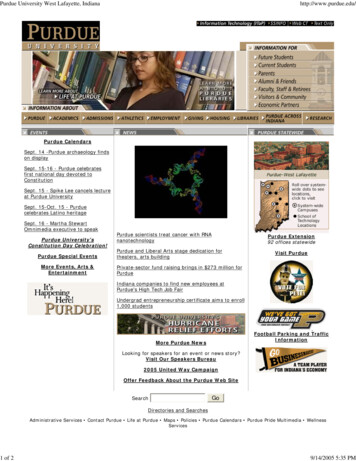
Transcription
CNS-ASU Report #R09-0001Heldrich Center’s Education ReportMay 2009A Profile of Nanotechnology DegreePrograms in the United StatesCarl Van HornRutgers, the State University of New JerseyJennifer ClearyRutgers, the State University of New JerseyLeela HebbarRutgers, the State University of New JerseyandAaron FichtnerRutgers, the State University of New JerseyJohn J. Heldrich Center for Workforce DevelopmentEdward J. Bloustein School for Planning and Public PolicyRutgers, The State University of New JerseyThe Center for Nanotechnology in SocietyArizona State UniversityThis research was conducted as part of the Center for Nanotechnologyin Society at Arizona State University (CNS‐ASU). CNS‐ASU research,education and outreach activities are supported by the National ScienceFoundation under cooperative agreement #0531194.
Education Report May 2009CNS‐ASU Report #R09‐0001This report is the third in a three-part workforce assessment study series that explores theemerging effects of nanotechnology on the demand for, and educational preparation of, skilledworkers. The series was designed to build policy-relevant knowledge of the labor marketdynamics of nanotechnology-enabled industries and to foster better alignment ofnanotechnology education with the skill needs of employers.The first report, The Workforce Needs of Companies Engaged in Nanotechnology Research inArizona, used interviews, focus groups, and an on-line questionnaire to profile a single labormarket - identifying the skill needs of high-tech companies in Arizona and the types ofnanotechnology educational programs being developed at post-secondary institutions in theregion. In the second report, The Workforce Needs of Biotechnology and PharmaceuticalCompanies in New Jersey That Use Nanotechnology, researchers used interviews ofrepresentatives from pharmaceutical and biotechnology companies to understandnanotechnology employer needs in New Jersey. This third report examines the emergingdevelopment of nanotechnology degree programs.1
Education Report May 2009CNS‐ASU Report #R09‐0001REPORT SUMMARYResearch suggests that new degree programs are one way that postsecondaryinstitutions respond to perceived labor shortages in areas of emergingtechnology (Stephan et al., 2007). This study offers a “snapshot” profile ofnanotechnology degree programs in the United States. While not the mostcommon, or even necessarily the most effective form of nanotechnologypostsecondary education, nanotechnology degree programs representinstitution‐level change, presumably to address new knowledge andemployment needs posed by nanotechnology.Nanotechnology degree programs are defined here as associate’s, bachelor’s,master’s and doctoral degrees that use the term “nano” in the formal degree title.To ensure the most complete coverage possible, researchers did not includecertificates, minors, tracks, or concentrations in nanotechnology. Researchersused structured Internet searches, expert recommendations, and existing degreeprogram lists, several of which are funded by the National Science Foundation,to identify degree programs (See Figure 1 below). The study also involved theanalysis of institutional data, 15 interviews with faculty associated with activedegree programs, and reviews of program‐related Websites. Researchers alsoconducted a total of 14 interviews with faculty from inactive or ineligibleprograms during the course of the study to better understand the obstacles toestablishing degree programs in nanotechnology.Figure 1. Comparison of nanotechnology degree programs, by list sourceNanotechnology Degree Program ListsThis ResearchThe Penn State University Center for NanotechnologyEducation and UtilizationNational Nanotechnology Initiative (NNI)National Center for Learning and Teaching NanoscaleScience and Engineering (NCLT)# NanotechnologyDegree Programs*49331413Small Times Survey 20079* Only programs meeting the definition established for this study were counted above.2
Education Report May 2009CNS‐ASU Report #R09‐0001FINDINGSSeven findings emerged from the study, as follows:Finding 1: The total number of formal nanotechnology degree programs in theUnited States is small, with associate’s degrees being the most prevalent,followed by doctoral degrees.Researchers identified 49 degree programs with the term “nano” in the degreetitle at 38 postsecondary institutions in the U.S. Thirty‐two (65%) of theseprograms are associate’s degree programs, more than half of which (18) are inPennsylvania. One program exists at the bachelor’s level, eight at the master’slevel, and eight at the doctoral level.Finding 2: Nanotechnology degree programs are not concentrated in areas ofhigh nanotechnology publication activity, but rather, clustered in response tofederal and state investments.While the majority of graduate‐level degree programs are housed at researchinstitutions, researchers found no correlation between the location ofnanotechnology degree programs and metro areas with high levels ofnanotechnology publication and patent activity, which are important indicatorsof innovation. Eleven of the sixteen graduate programs identified were offeredby institutions that perform high or very high levels of research according to theCarnegie Classification system. 1 Only 2 of the 38 institutions, however, were inone of the top 10 “nanodistricts”, metropolitan areas with the highest rates ofnanotechnology publication and patent activity (Shapira and Youtie, 2008).Instead, programs are clustered in areas where state and/or federal investmentspromoted their growth. In the cases of Pennsylvania and New York, needs ofcurrent employers and economic development goals drove the creation ofstatewide nanotechnology initiatives, which in turn supported the developmentof degree programs. In the Midwest, the National Science Foundation supportedthe development of NANO‐LINK, a set of six associate’s degree programs linkedacross five states.1The Carnegie classification system is a coding system developed by the Carnegie Commission on Higher Education toassist researchers and policy analysts to categorize schools by key characteristics. For more information ons/3
Education Report May 2009CNS‐ASU Report #R09‐0001Finding 3: Workforce and economic development are key motivators for thecreation of associate’s degree programs in nanotechnology, while reasons forcreating other types of degrees are more diverse.All ten associate’s degree program faculty interviewed cited workforcedevelopment and business attraction as key reasons for creating their programs.For example, the Pennsylvania Nanofabrication Manufacturing TechnologyNetwork, which links 18 nanotechnology degrees across 16 institutions to acapstone semester at Pennsylvania State University, began as a result ofemployers asking state workforce and economic development officials for help intraining nanotechnology technicians. According to administrators, the programis also designed to attract more nanotechnology-enabled manufacturers to the state.At the bachelor’s level and above, motivations for creating degree programswere more variable. Some, such as The College of Nanoscale Science andEngineering at the University at Albany, State University of New York, werecreated as part of state or local initiatives to support and grow nanotechnologybusinesses. However, other programs cited a desire to attract more students andfaculty interest in formally linking nanotechnology education across disciplines.Finding 4: Employer involvement in degree programs is inconsistent.Employer involvement in nanotechnology degree programs varies acrossprograms, even among those with a workforce development mission. While allassociate’s degree programs contacted reported some level of employerinvolvement, the degree and type of involvement varied from initial consultationabout program design, to ongoing involvement in curriculum development,internships, funding assistance and job placement. At higher levels of education,where motivations for program development are more variable, employerinvolvement of any kind was less common. The major exception to this is at theCollege of Nanoscale Science and Engineering in New York, where six graduatedegree programs involve high levels of industry partnership.Finding 5: A shortage of qualified faculty, limited consensus on learningneeds, and other factors contribute to varied approaches to theinterdisciplinary aspects of nanotechnology education in degree programs.All programs contacted use pre‐existing courses from different disciplines – anapproach known as “synthetic interdisciplinarity” (Lattucca 2001). Several,however, involved faculty from multiple disciplines to create new course content4
Education Report May 2009CNS‐ASU Report #R09‐0001that emphasized the common elements linking various disciplines, known as a“transdisciplinary” approach (Lattucca 2001).Especially at the associate’s level, the lack of transdisciplinary courses was linkedto difficulties finding qualified faculty. This issue is often addressed throughpartnerships with four‐year universities, where students have access to moretransdisciplinary coursework, as well as advanced lab equipment. Programpurpose, faculty perceptions of needed knowledge, and structural barriers, suchas faculty reward structures and accreditation requirements also appear tocontribute to differences in program approaches to interdisciplinarity. Somefaculty worried that overemphasis on interdisciplinary education would dilutecore, discipline‐based knowledge.Finding 6: Partnerships among related programs were common, especiallyacross institutions.Graduate degree programs reported informal ties to nanotechnology researchcenters at the same institution, while partnerships across institutions at all levelswere both common and formal. The NSF‐funded Pennsylvania NanofabricationManufacturing Technology Network and NANO‐LINK programs developedpartnerships both among several community colleges and between these schoolsand universities. Locally‐driven partnerships have also developed in other areason a smaller scale. Inter‐institutional partnerships, as mentioned above, includecapstone semesters and lab rotations offered at four‐year institutions forassociate’s‐level students, as well as formal articulation agreements that allowstudents to transition from an associate’s degree in nanotechnology to abachelor’s degree in a traditional discipline, often with a nanotechnology ornanoscience focus.Finding 7: Little is known about the employment outcomes of nanotechnologydegree program graduates.Few students have completed the nanotechnology degree programs contacted.Further, few programs have systems in place to track graduate outcomes.Anecdotal reports indicated that students either went on to higher levels ofeducation or found relevant nanotechnology positions at competitive salaries.Overall, however, very little information was available about student outcomes.5
Education Report May 2009CNS‐ASU Report #R09‐0001CONCLUSIONSSeveral conclusions are important for policymakers to consider. These include:The development of nanotechnology degree programs reflects the emergingnature of the technology itself.While much has been written about the potential of nanotechnology to transformindustries and education, only early signs of transformation are evident in bothtoday. Stephan et al. (2007) found that most nanotechnology postsecondaryeducation is occurring informally in university lab environments, not withinformal degree programs. Research with employers also suggests that employerstrain many nanotechnology workers on the job (Van Horn and Fichtner, 2008;Van Horn et al., 2009). This research, which reveals few formal programs andvariations in focus and content among them, demonstrates that, like thetechnology itself, educational approaches to nanotechnology are still emerging.Not surprisingly, the value of formal degree programs for meeting employerneeds is unclear.Because many nanotechnology degree programs are new, little is known aboutthe success of graduates in the labor market. Recent studies have revealedlimited demand for skilled nanotechnology workers (Stephan et al. 2007) andmany employers do not yet see value in a nanotechnology specific degree (VanHorn and Fichtner 2008; Van Horn, Fichtner, and Cleary 2009). Plus, the fact thatdegree programs are not associated with publication and patent activity suggeststhat, at least as currently structured, they may not play a significant role in theinnovation process.Employer involvement in many associate’s degree programs, however, mayindicate an emerging need for technician‐level skill development innanotechnology. Further, just as few employers saw value in an informationtechnology degree in 1972, limited demand for workers with a nanotechnologydegree may reflect employers’ limited understanding of the future skillimplications of an emerging technology. As a result, nanotechnology degreesmay prove to be more valuable in the marketplace as the technology itselfmatures.6
Education Report May 2009CNS‐ASU Report #R09‐0001POLICY IMPLICATIONS AND FUTURE RESEARCH OPPORTUNITIESThe research has implications for current policies that support the developmentof educational approaches to nanotechnology and suggests areas for furtherresearch. Based on the results of this study, policymakers at the National ScienceFoundation should consider the following:¾ Continue support for experimental approaches to nanotechnologypostsecondary education until proven models emerge,¾ Encourage employer involvement in curriculum development, thecreation of more transdisciplinary content, and continued partnershipdevelopment,¾ Support further research on postsecondary degree program processes andoutcomes, as well as those for other types of nanotechnology education.7
Education Report May 2009CNS‐ASU Report #R09‐0001FULL REPORTINTRODUCTIONExperts predict moderate to strong growth in the emerging field ofnanotechnology, especially after 2010 (Hullman, 2006; M.C. Roco, 2003). Whilethe current international recession may slow the pace of demand, Hullmanargues that it could eventually become as pervasive as information andcommunication technologies.As demand for products that incorporate nanotechnology rises, Americancolleges and universities will come under increasing pressure from employersand policymakers to prepare a skilled, nano‐literate workforce. Many scientists,employers, and educators agree that nanotechnology requires interdisciplinaryskills and knowledge – knowledge that may transcend traditional disciplinaryboundaries (Van Horn & Fichtner, 2008; Van Horn et al., 2009; Wansom et al.,2008).While there is no consensus yet on the best form or method to teach futurenanotechnology workers, colleges and universities are developing a variety ofcourses, certificates, minors and degree majors that focus on nanotechnology(Stephan et al., 2007; Wansom et al., 2008). Currently, most nanotechnologyeducation occurs informally in university labs, as well as through electivecourses (Stephan et al., 2007). This study sheds light on one of the newest, mostvisible, and most formal incarnations of nanotechnology education at the post‐secondary level in the United States ‐ nanotechnology degree programs.The purpose of this study is to build new policy‐relevant knowledge aboutnanotechnology degree programs at colleges and universities in the UnitedStates. It identifies existing programs, as well as the institutions anddepartments that house them, and describes key program characteristics andtrends across programs. This work adds to the sparse knowledge that has beendeveloped regarding the ways that American colleges and universities areadapting to the education and workforce preparation challenges nanotechnologypresents.The report will address the following research questions:¾ At what education levels do degree programs tend to occur?8
Education Report May 2009CNS‐ASU Report #R09‐0001¾ Which types of institutions are implementing degree programs?¾ Where are programs located? To what extent are programs clustered inareas with state, regional, or local nanotechnology initiatives or highnanotechnology publication activity?¾ How are programs structured to deal with the interdisciplinary aspects ofnanotechnology?¾ What is the role of employers in these programs?¾ What factors were important in the development of these programs?¾ What partnerships exist among nanotechnology degree programs andother education and research programs in nanotechnology and relatedfields?¾ What is known about the employment and education outcomes ofstudents?While little is known about the most effective form of nanotechnology educationgiven the emerging nature of the field, formal nanotechnology degree programsare nonetheless important to study. Degree programs represent institution‐levelchange to accommodate nanotechnology, as well as a public statement on thepart of the institution that this is an important new area of knowledge. Theprocess through which a degree program is added is lengthy and time‐consuming, requiring commitment on the part of faculty, administrators, andstaff. Nanotechnology degree programs are also somewhat more comparableacross institutions than other forms of nanotechnology education.Limitations of the study include the fact that it covers only a small portion ofnanotechnology education practices in the U.S. It does not address other formsof nanotechnology education at the post‐secondary level, nor does it covereducational practices at other levels of education, which some scholars believeare necessary components to preparing a skilled nanotechnology workforce forthe future (M. C. Roco, 2003; Wansom et al., 2008). In addition, while many stepswere taken to ensure adequate coverage of all current degree programs, thedifficulties and cost involved in surveying all higher education institutions and9
Education Report May 2009CNS‐ASU Report #R09‐0001departments make it difficult to know if this list represents a comprehensivereview of all degree programs.As new research on effective pedagogy, program structure, and course contentassociated with nanotechnology workforce education emerges, the value of thedegree program models discussed in this report will become more apparent. Inthe meantime, this research provides policymakers and educators withimportant information about the number and types of nanotechnology degreescurrently in place in the U.S., as well as key trends associated with theirdevelopment. The study also adds to the sparse literature available on the waysthat colleges and universities are responding to the educational challenges posedby nanotechnology and the demand for skilled nanotechnology workers.10
Education Report May 2009CNS‐ASU Report #R09‐0001LITERATURE REVIEWThis section discusses areas of the scholarly literature that informed thedevelopment and implementation of this study. In includes a review of studiesthat discuss the emerging demand for a skilled nanotechnology workforce,implications of nanotechnology for U.S. higher education, and the current stateof knowledge regarding the educational approaches to nanotechnology beingdeveloped at U.S. postsecondary institutions.Demand for Nanotechnology WorkersAn often quoted estimate promulgated by the National Science Foundationprojects that 2 million nanotechnology workers will be needed worldwide by2015, including 800,000 to 900,000 in the U.S. alone (M. C. Roco & Bainbridge,2001). While the current international recession may slow the pace of demand,Hullman (2006) notes that a range of studies agree that growth is likely to surgeafter 2010.Today, however, demand for skilled nanotechnology workers appears limited. Astudy of job postings from several prominent sources conducted by Stephan et al.(2007) indicated that demand for nanotechnology workers with a bachelor’sdegree or above was in the range of hundreds of workers nationwide in 2005.While this represented annual growth rates of up to 43% per year over a threeyear period (2002‐2005), the overall market is still small. Positions were spreadacross academic, government and non‐profit organizations, as well as privatefirms. Yet, the study found that most advertisements were placed by large,established firms as opposed to small companies. This may be a function of thecost of placing ads, but it could also represent limited nanotechnology workamong small or emerging firms.Stephan’s findings are consistent with case studies performed as part of thelarger NSF‐funded CNS‐ASU workforce assessment project that funded thisresearch. An analysis of the hiring needs of firms using nanotechnology inArizona found limited employer demand for highly skilled nanotechnologyworkers (Van Horn & Fichtner, 2008). Limited case studies of pharmaceuticaland biotechnology firms in New Jersey revealed that even large firms are hiringvery few nanotechnology workers and are unsure of their future hiring needs inthis regard (Van Horn et al., 2009).11
Education Report May 2009CNS‐ASU Report #R09‐0001Overall, it is difficult to predict the rate at which the demand for nanotechnologyworkers will grow. As noted in Hullman’s work, a review of market analysisstudies shows consensus regarding the potential for growth, but significantvariation in the pace and timing of this growth, especially prior to 2010.Implications of Nanotechnology for Higher Education in the United StatesSeveral studies have explored the types of skills and knowledge that employersrequire of nanotechnology workers. While specifics vary by industry andapplication, employers and academics agree that nanotechnology requires asignificant amount of interdisciplinary knowledge across multiple science andengineering areas (M. C. Roco, 2003; Van Horn & Fichtner, 2008; Van Horn et al.,2009; Wansom et al., 2008). This will require colleges and universities to developstudents who have the breadth and depth of scientific knowledge needed toenable both research‐based and commercial advancements in nanotechnology.In 2006 and 2007, the National Center for Learning and Teaching NanoscaleScience and Engineering, which is funded by the National Science Foundation,supported several workshops to identify “big ideas” and key goals fornanotechnology‐related education. These workshops identified nine broadknowledge and skill areas important to nanotechnology education including:size and scale; surface‐to‐volume ratio, surface‐dominated behavior; self‐assembly; quantum mechanics; size‐dependent properties, tools/instruments andcharacterizations; models and simulations; and societal impact (Wansom et al.,2008). Much has been written on the ethical, legal and social implications ofnanotechnology and the importance of teaching students about these (Kjolberg &Wickson, 2007; Mnyuswalla, Daar, & Singer, 2003; M. C. Roco & Bainbridge,2001; M. C. Roco, 2003; M. C. Roco, 2003).This study did not include an examination of these knowledge elements andwhether they were present in nanotechnology degree programs. However, asemployers and experts agree that interdisciplinary education is necessary toachieve these knowledge objectives (Van Horn & Fichtner, 2008; Van Horn et al.,2009; Wansom et al., 2008), this study looks broadly at how educationalinstitutions approached the issue of interdisciplinarity within their degreeprograms.12
Education Report May 2009CNS‐ASU Report #R09‐0001Lattuca (2001) provides a useful framework for understanding universityapproaches to interdisciplinarity. She identified three key types ofinterdisciplinary education. The first, and weakest, form is called informeddisciplinarity, which involves education based in a core discipline thatincludes additional information about another area of knowledge. Lattucadescribes the second form, Synthetic interdisciplinarity, as a side‐by‐sidepresentation of concepts from various disciplines. Finally, transdisciplinaritystresses underlying connections among disciplines. It appears to be thisthird form that some visionary experts in the field of nanotechnologyespouse (M. C. Roco, 2003; Wansom et al., 2008). However, not all facultyand employers appear to agree that this level of interdiscipliarity is requiredor preferable (Stephan et al., 2007; Van Horn & Fichtner, 2008; Van Horn etal., 2009; Vogel & Campbell, 2002).While there is some emerging agreement among employers and science expertson the broad types of skills and knowledge future nanotechnology workers needto have, there is no consensus on how best to structure undergraduate andgraduate teaching and research activities to promote that learning. The debateabout the extent of interdisciplinary knowledge students need and the best waysto structure teaching is still active.Educational Responses to Nanotechnology in American Colleges and UniversitiesHow are U.S. colleges and universities responding to the challenge of producingstudents who are prepared to help American businesses and research centersrealize the potential of nanotechnology? While nanotechnology is relatively newin the private sector, academics have been advancing knowledge aboutnanotechnology for decades. As early as 1959, Richard Feynman gave a classictalk to the American Physical Society at the California Institute of Technology(Caltech) entitled, “There’s Plenty of Room at the Bottom,” where he describedthe manipulation of matter down to the atomic level. (Feynman, 1960 –engineering and science reference) The invention of the scanning tunnelingmicroscope in 1981, which allows researchers a clear view of atomic surfaces, andthe atomic force microscope in 1986, which allows viewing at the sub‐atomicnanoscale, provided important tools for the advancement of nanotechnologyresearch.13
Education Report May 2009CNS‐ASU Report #R09‐0001Academic departments ranging from physics to materials science have, overtime, developed both formal and informal ways to teach students aboutnanotechnology.While very little is known about nanotechnology education in colleges anduniversities, Stephan et al. (2007) found that most nanotechnology educationoccurs informally in laboratories. Other nanotechnology education practicesrange from modified course content to new classes, as well as certificateprograms, minors, concentrations and tracks within degree programs, and someformal major degree programs (Stephan et al., 2007; Wansom et al., 2008).Wansom et. al found wide variations in the content and structure of courseworkin degree programs and minors across several postsecondary institutions.Stephan et al. and others identified several potential barriers to establishingformal nanotechnology degree programs including the fact that they need tospan several disciplines, which requires inter‐departmental cooperation. Otherkey barriers included the lack of faculty with the interdisciplinary backgroundneeded to teach effectively and the often daunting degree requirements fornanotechnology which may add on to coursework in core disciplines (Stephan etal., 2007). Other difficulties included the concerns among faculty about thecurricula of nanotechnology degree programs being more “general” than isneeded to give students depth of knowledge in core disciplines, as well as aconcern that the field is too nascent to warrant its own degree programs (Vogel &Campbell, 2002). Wansom et. al (2008) also found that degree programs centeredon particular disciplines faced the challenge of having few faculty membersproperly trained in the interdisciplinary aspects needed to teach all necessarynanotechnology concepts. These authors also noted that accreditation bodies andstructural barriers within universities limited the ability of programs to spanmultiple disciplines well.14
Education Report May 2009CNS‐ASU Report #R09‐0001METHODS AND DATAThis section describes the methods and data sources that researchers used todefine and identify nanotechnology degree programs, and to identify salientcharacteristics of programs and the institutions that offer them.Defining Nanotechnology Degree ProgramsFor the purposes of this study, researchers defined nanotechnology degreeprograms to be postsecondary degree programs at the associate’s, bachelor’s,master’s, or doctoral level that contained the term “nano” in the formal degreetitle. This definition excludes degree minors, tracks, and other types of sub‐specializations. In addition, it does not include other types of post‐secondarycredentials, such as graduate and professional certificates, nor does it includestand‐alone nanotechnology courses or modules, or informal research‐basednanotechnology education performed at colleges and universities.This narrow definition of nanotechnology degree programs was chosen forseveral reasons. First, as indicated in the introduction, establishing a major areaof study in the form of a new formal degree program represents a significantinstitutional commitment to a new area of knowledge development. Adding atrack or a minor to a pre‐existing degree program is less significant in thisregard. The use of the term “nano” in the formal degree title is assumed toreflect a serious intention by the institution and the program to establish aprimary, rather than a secondary, focus on nanoscience and/or nanotechnology.Also, given the Web‐based search methods available to identify programs (seebelow for more information), this definition enhanced the likelihood that thisstudy would result in a comprehensive identification of degree programs in theUnited States. Finally, focusing on programs with the term “nano” in the titleoffered a degree of comparability among programs, especially given the widerange in the types of nanotechnology education provided at postsecondaryinstitutions.Identification of Nanotechnology Degree ProgramsResearchers used multiple methods to identify nanotechnology degreeprograms. Due
The Penn State University Center for Nanotechnology Education and Utilization 33 National Nanotechnology Initiative (NNI) 14 National Center for Learning and Teaching Nanoscale Science and Engineering (NCLT) 13 Small Times Survey 2007 9 * Only programs meeting the definition established for this study were counted above. 2










